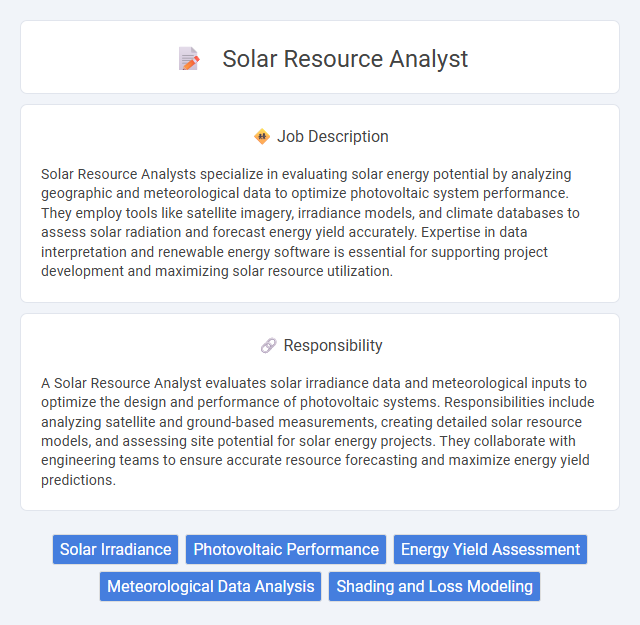
Solar Resource Analysts specialize in evaluating solar energy potential by analyzing geographic and meteorological data to optimize photovoltaic system performance. They employ tools like satellite imagery, irradiance models, and climate databases to assess solar radiation and forecast energy yield accurately. Expertise in data interpretation and renewable energy software is essential for supporting project development and maximizing solar resource utilization.
Individuals with strong analytical skills and a passion for renewable energy are likely suited for a Solar Resource Analyst role, as the job requires interpreting complex solar data and forecasting energy production. Those comfortable working with advanced software tools and handling detailed environmental information may find themselves adept at optimizing solar project outcomes. However, people preferring less technical or outdoor-focused work may find this position less compatible with their strengths and interests.
Qualification
A Solar Resource Analyst must possess strong expertise in meteorology, solar radiation data, and geospatial analysis to accurately assess solar energy potential. Proficiency in software tools such as PVsyst, ArcGIS, and MATLAB is essential for modeling and interpreting solar resource data. A degree in environmental science, renewable energy, or engineering, combined with experience in data analytics and site assessment, is highly preferred for this role.
Responsibility
A Solar Resource Analyst evaluates solar irradiance data and meteorological inputs to optimize the design and performance of photovoltaic systems. Responsibilities include analyzing satellite and ground-based measurements, creating detailed solar resource models, and assessing site potential for solar energy projects. They collaborate with engineering teams to ensure accurate resource forecasting and maximize energy yield predictions.
Benefit
A Solar Resource Analyst likely enhances project efficiency by accurately assessing solar energy potential, which can lead to cost savings and optimized system design. This role potentially supports better decision-making with detailed data analysis, improving project feasibility and investment confidence. Employers may gain a competitive advantage through improved energy forecasting and resource management.
Challenge
A Solar Resource Analyst likely faces the challenge of accurately interpreting complex environmental data to forecast solar energy potential, which may be impacted by variable weather patterns and geographic differences. The role probably demands proficiency in advanced software and modeling tools to ensure precise assessments, increasing pressure to deliver reliable predictions under tight deadlines. Handling large datasets with possible inconsistencies also appears to be a common difficulty in maintaining the quality and relevance of solar resource evaluations.
Career Advancement
A Solar Resource Analyst plays a crucial role in evaluating solar energy potential through data collection, site assessments, and weather pattern analysis, driving efficient solar project development. Mastery in geospatial analysis software, remote sensing technology, and energy modeling enhances expertise, positioning professionals for senior technical roles or project management opportunities. Advancing in this career often involves specializing in renewable energy policy, environmental impact assessments, or pursuing certifications such as NABCEP, leading to leadership positions in the renewable energy sector.
Key Terms
Solar Irradiance
Solar Resource Analysts specialize in assessing solar irradiance to optimize photovoltaic energy production and project feasibility. They utilize satellite data, ground measurements, and radiative transfer models to quantify direct, diffuse, and global horizontal irradiance. Expertise in irradiance variability, seasonal patterns, and atmospheric conditions is essential for accurate solar resource assessment and energy yield forecasting.
Photovoltaic Performance
A Solar Resource Analyst specializing in Photovoltaic Performance evaluates solar irradiance data and system efficiency to optimize energy yield predictions for photovoltaic installations. This role involves analyzing satellite data, weather patterns, and shading impacts to model the solar energy generation potential accurately. Expertise in software tools like PVsyst and SAM enhances precise performance forecasting and supports project development decisions.
Energy Yield Assessment
Energy Yield Assessment for a Solar Resource Analyst involves in-depth analysis of solar irradiance data, weather patterns, and site-specific conditions to predict the potential energy output of photovoltaic systems. Utilizing advanced software tools and meteorological databases, analysts model energy production to optimize system design and financial feasibility. Accurate assessments reduce investment risks and enhance performance forecasting for solar power projects.
Meteorological Data Analysis
Solar Resource Analysts specialize in meteorological data analysis to assess solar energy potential by collecting, processing, and interpreting weather and sunlight patterns. They utilize advanced statistical tools and satellite data to evaluate solar irradiance, temperature, and atmospheric conditions, ensuring accurate forecasting for solar project feasibility. Proficiency in software like PVsyst and Python for data modeling is essential to optimize solar energy yield and support sustainable energy planning.
Shading and Loss Modeling
Solar Resource Analysts specializing in Shading and Loss Modeling conduct detailed assessments of solar site conditions to quantify shading impacts and energy losses using advanced simulation software like PVsyst and Helioscope. They analyze terrain data, obstructions, and panel orientation to optimize system design and maximize photovoltaic energy yield. Expertise in modeling diffuse and direct irradiance losses directly contributes to accurate performance forecasting and financial projections for solar projects.
 kuljobs.com
kuljobs.com